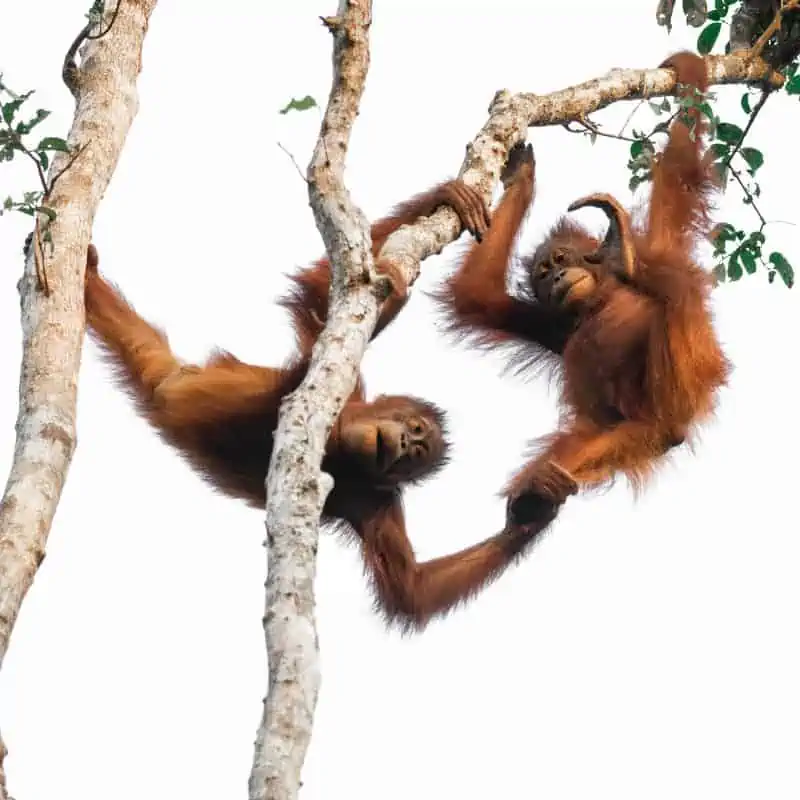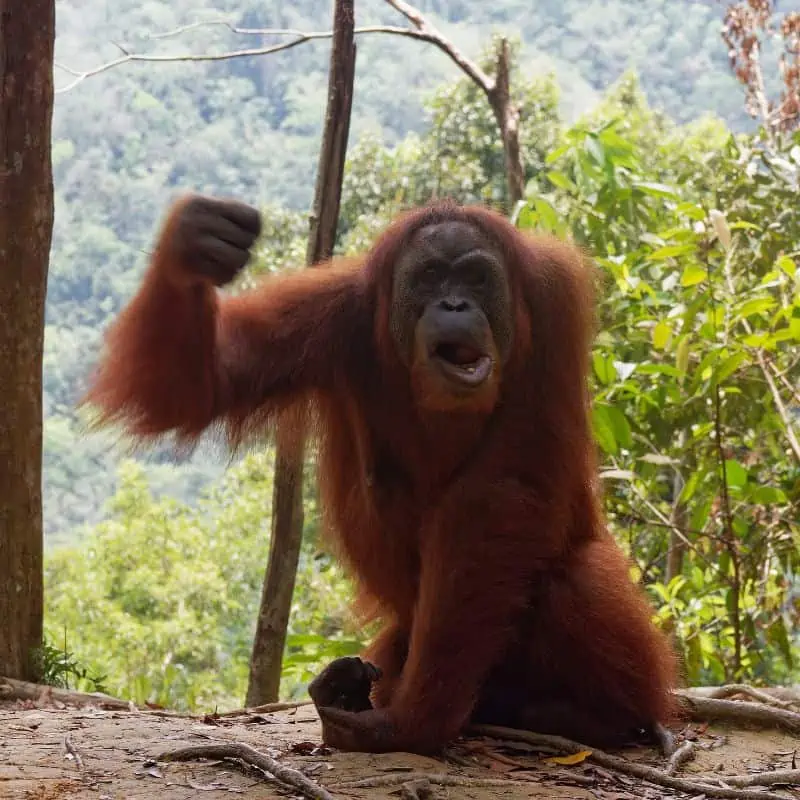Orangutans are one of the most lovable and charismatic animals on the planet. They’re also huge, strong, and potentially dangerous. So are orangutans dangerous, or is that just our perception?
Orangutans are not dangerous. They’re mild-mannered, inquisitive, and friendly towards humans. However, like all wild animals, they can become aggressive if they perceive a threat.
Are you curious to learn more about their dangers and what to do if you encounter one? Then read on for everything you need to know about orangutans.

What makes orangutans dangerous?
Orangutans are mighty animals known to break bamboo with their bare hands and can also rip open coconuts with their teeth.
Some distinguishing features that make them dangerous include:
1. Weight and height
Adult male orangutans can weigh over 200 pounds (90 kg), and females can weigh up to 140 pounds (64 kg).
They are about 4 feet (1.2 m) tall when standing on their hind legs but can reach up to 6.5 feet (2 m) when they swing from tree to tree.
2. Long arms
Orangutans have long, stocky, powerful arms to swing from branches and build nests.
Their arm span can reach up to 7 feet (2.2 m) long from fingertip to fingertip. Due to such sturdy arms, they have a strong grip and can lift 500 pounds (227 kg).

3. Bite strength
Orangutans have the same number of teeth as humans, 32, but with more prominent canines and incredibly powerful jaws.
They can bite with a force of up to 575 PSI, almost four times stronger than humans’ 162 PSI.
An Interesting Experiment:
Scientists from the University of Oxford’s WildCRU studied the seeds of the plant Mezzettia parviflora (Annonaceae) to discover what makes them so difficult to crack open.
Parviflora predators, like Orangutans, split the seed by cracking the wooden plug, the soft and weak portion of the seed from where seedlings emerge.
Further field observations revealed that Orangutans in Sabangau and Borneo consume an average of about 120 seeds per day. The jaw strength required is equal to six people bearing down on the seed.
So, are orangutans dangerous to humans? Let’s dig a little deeper and find out.
Are orangutans dangerous to humans?
Orangutans are generally gentle giants. However, they are still wild animals and have the potential to be dangerous to humans.
There have been instances of orangutans becoming aggressive towards humans, usually when they feel threatened or are protecting their territory. Male orangutans can also become aggressive during mating season to compete for mates.
While orangutans are not typically dangerous to humans, it is important to be aware of their potential to be dangerous and to take precautions when interacting with them.
Have there been any orangutan attacks on humans?
Despite their gentle nature, orangutans can be dangerous if they feel threatened. They can use their strong jaws and sharp canines in defense if they feel they are in danger.
Additionally, Their hands are made for gripping branches and holding on. This means their hands are massive and can easily wrap around a human’s wrist, resulting in a broken arm.
This can be a deadly combination if you are not cautious.
Here are some examples of what can happen if you’re not careful around orangutans. They might look friendly, but they are still wild animals and can be dangerous.

Example #1: Held hostage by an orangutan
Jackie, an Orangutan, grabbed a woman’s hand in Bukit Lawang Jungle while on tour with her friends. The grip was so firm that she could not get rid of the Orangutan even after much struggle. Eventually, the Orangutan let her go after taking all the food from the tourists.
Example #2: Grabbing a man at an enclosure
A young man can be seen in the following video caught by an Orangutan. The Orangutan caught his shirt when he came too close to the enclosure to get a better view. Although the Orangutan was in the cage, it still had a firm grip, and the man could hardly escape without the help of the other people in the area.
How should we approach an orangutan?
The best way to avoid getting injured by an orangutan is to give them the space they need and not approach them. Although they are generally gentle, they are wild animals and can act aggressively if they feel threatened.
If you do find yourself close to an orangutan, remain calm and avoid making any sudden movements.
If the orangutan attacks, try to be calm, protect your head and face as much as possible, and offer fruit to get them away from you.
Guidelines for a safe visit with orangutans
When visiting orangutans, it is important to know some guidelines to minimize your impact on these primates.
Here are some key points to remember:
- Don’t feed orangutans without permission from the management.
- Refrain from moving around or disturbing the orangutans.
- Wear protective masks and stay away if you feel ill, as humans are highly contagious to orangutans.
- Keep noise levels down and avoid any potential disturbance to the primates.
- Limit your visit time, preferably no more than two hours at feeding camps and one hour in the wild.
- Be vigilant of your children and keep them close at all times.
Follow these guidelines to help ensure a safe and respectful visit for you and the orangutans.
Final thoughts on how dangerous orangutans are
Orangutans are not dangerous animals, but like all wild animals, they can act aggressively if they feel threatened.
The best way to avoid getting injured by an orangutan is to give them the space they need and not approach them.
FAQs
Are orangutans dangerous to each other?
Orangutans are not territorial like other animals, so they do not fight for space or food.
However, males can become aggressive during mating season. Females will also sometimes fight for the best nesting sites. The first ever deadly fight recorded occurred in 2016.
Do orangutans have any natural predators?
Orangutans do not have many natural predators, but they can be killed by large predators such as tigers, leopards, and crocodiles.
How close are orangutans to humans?
Orangutans share about 97% of their DNA with humans, making them the closest living relative to humans.
This high percentage of shared DNA means that orangutans can learn and understand human language to a certain degree.

